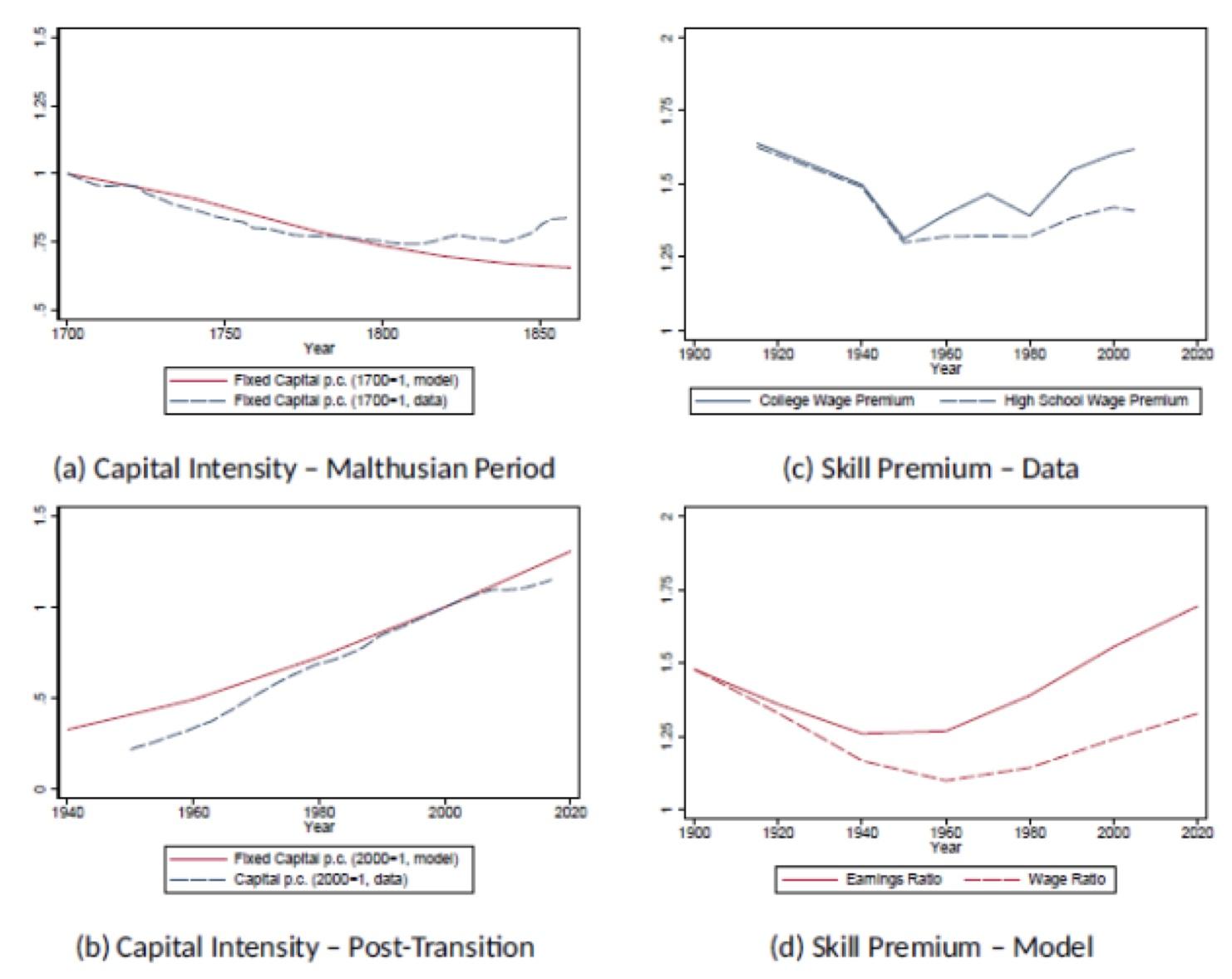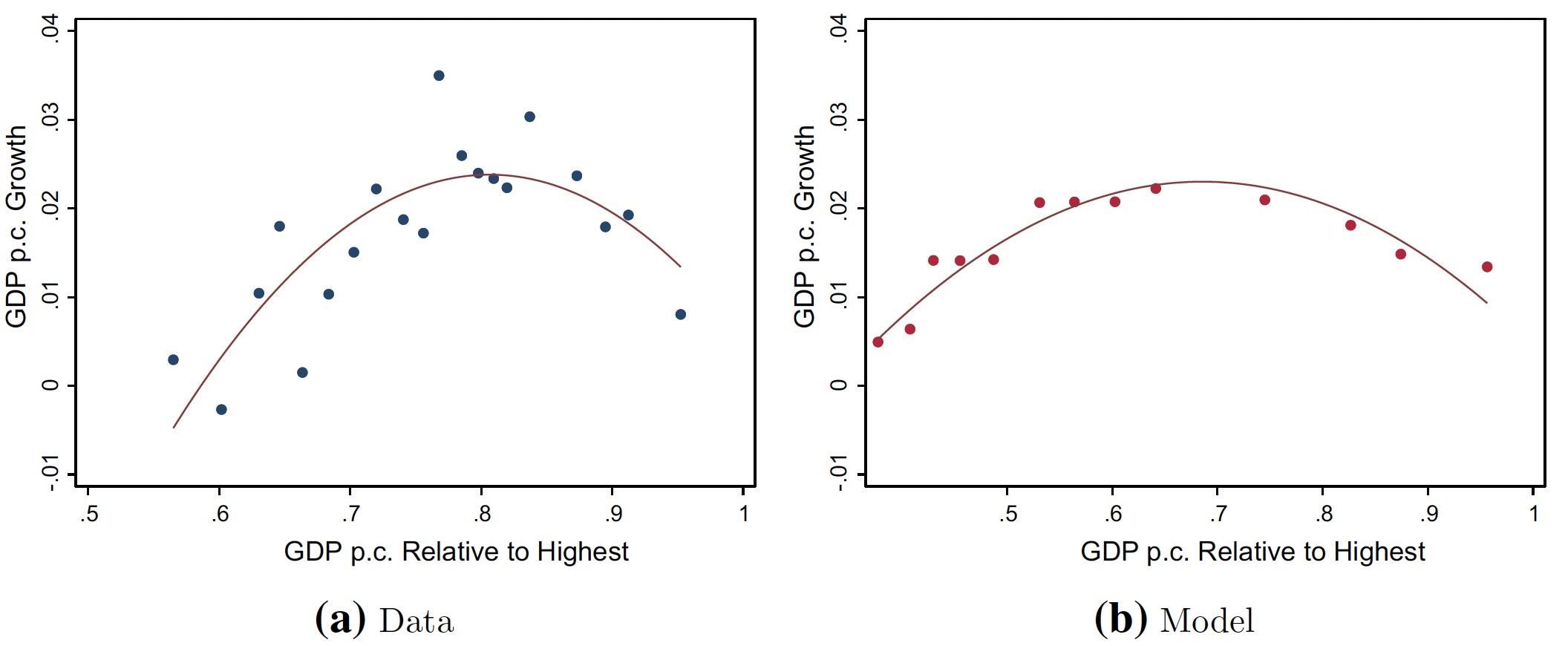Over the past decades, the economic growth literature has made considerable progress in understanding the mechanics of long-run growth, empirical patterns of growth, and the patterns of comparative development. However, although textbook models of economic growth successfully incorporated the famous ‘Kaldor facts’ (Kaldor 1957), many aspects of long-run development remain difficult to rationalise with conventional models of endogenous growth. New stylised facts that relate to the non-linear and intertwined dynamics of income, demographic variables, and returns to factors of production require a better understanding. These include the substantial but non-monotonic increase of population size, the acceleration of economic growth from quasi-stagnation to sustained growth rates, the increasing variability of growth rates with greater distance to the technology frontier, persistent cross-country differences in income and factor productivity, sustained increases in human capital per worker, and non-monotonic dynamics of the skill premium (e.g. Jones and Romer 2010, Jones 2016).
With their focus on the mechanics behind the transition from stagnation to growth, unified growth models offer a natural starting point for the study of the facts that are related to non-linear dynamics (e.g. Galor 2011). However, existing models typically focus on human capital formation for long-run dynamics at the cost of abstracting from physical capital accumulation and the role of heterogeneity and interdependencies across countries. The quantitative relevance of the unified growth approach and its predictions for the empirical patterns of growth over time and across countries remains a largely underexplored area.
In a recent paper (Cervellati et al. 2022), we develop a tractable unified growth theory that explicitly accounts for physical capital accumulation and a capital-skill complementarity. In the model, the demographic transition represents the key turning point in the dynamics of all state variables. In particular, technological progress induces the accumulation of physical capital, which, due to capital-skill complementarities in production, eventually triggers an expansion of human capital and a decline in fertility – the demographic transition. We show that a quantitative version of the model can account for the stylised empirical patterns of long-run growth, including dynamics in factor returns, the skill premium, and factor income shares. Figure 1 illustrates this by plotting the dynamics of the state variables and by comparing long-run dynamics in the data and in the model for selected variables (here output and population).
Figure 1 Long-run dynamics
The resulting dynamics are consistent with a large set of seemingly unrelated empirical observations. For example, as illustrated in Figure 2, in spite of a monotonic increase in the aggregate stock of human capital and physical capital that resembles historical patterns (de Pleijt and Broadberry 2021), both capital per worker and the skill premium exhibit non-monotonic dynamics. Prior to the demographic transition with its expansion of human capital, capital endowments exhibited a downward trend, whereas capital intensity exhibited an upward trend after the transition. These dynamics reflect the complementarity between physical capital and human capital that has been emphasised previously (e.g. Sampson et al. 2016) and are mirrored by the dynamics of the returns to capital. Similarly, the skill premium exhibits a U-shaped pattern as the result of the interplay of technological change, capital-skill complementarity, and the non-monotonic expansion of the stock of human capital.
Figure 2 Non-monotonic dynamics
Studying a multi-country version of the model, with the only heterogeneity across countries being the initial level of productivity, sheds new light on comparative development across countries and on the interpretation of growth regressions. In particular, the model rationalises comparative development differences in TFP and income as the result of delays in the demographic transition relative to the global forerunner countries. Similar insights apply to cross-country differences in capital intensity per worker and in marginal returns to capital. The model dynamics also predict a hump-shaped growth pattern with a temporary overshooting over the long-run balanced growth path of income as the result of non-recurring, secular transitions in fertility and education. Regarding the growth dynamics across countries, this implies that relative to the frontier countries, low-income countries exhibit lower growth rates, whereas countries undergoing their demographic and economic transition exhibit higher growth rates than the frontier economies (see Figure 3). This can help rationalise the recent secular stagnation in growth rates among developed economies and the greater variability of growth rates across emerging economies and low-income countries. The importance of the demographic transition as the turning point of a country’s growth dynamics is also illustrated by the similarity of estimates of reduced-form growth empirics obtained with actual data and with simulated data.
Figure 3 Comparative development
Extending the model to the consideration of the diffusion of technologies from the world frontier across countries provides further insights into the importance of the interplay between demographic development and education expansion. Since human capital facilitates the adoption of new technologies from the world frontier, the model predicts that countries with a later demographic transition should experience greater lags until new technologies are adopted, and a lower intensity of adoption. Evidence supports these novel predictions offering insights for the interpretation of the empirical patterns of technology diffusion and insights into seemingly contradictory convergence patterns (e.g. di Vaio et al. 2013).
Taken together, the results underscore the importance of accounting for the demographic transition for a better understanding of patterns of long-run growth and comparative development above and beyond monotonic demographic change (Henriksen and Cooley 2018). They also show the usefulness of quantitative unified growth models for rationalising the stylised facts of long-run growth both over time and across countries.
References
Cervellati, M, G Meyerheim, and U Sunde (2023), “The Empirics of Economic Growth Over Time and Across Nations: A Unified Growth Perspective" Journal of Economic Growth, forthcoming.
De Pleijt, A, and S Broadberry (2021), “Capital and economic growth in Britain 1270—1870: Preliminary findings”, VoxEU.org, 4 April.
Di Vaio, G, J Zeira, and G Battisti (2014), “A new look at global convergence and divergence”, VoxEU.org, 9 January.
Henriksen, E, and T Cooley (2018), “Demographics and long-run growth”, VoxEU.org, 11 June.
Galor, O (2011), Unified Growth Theory, Princeton University Press.
Jones, C I (2016), “The Facts of Economic Growth”, in J B Taylor and H Uhlig (eds), Handbook of Macroeconomics, Vol. 2, pp. 3-69.
Jones, C I, and P Romer (2010), “The New kaldor facts: Ideas, institutions, population, and human capital”, American Economic Journal: Macroeconomics 2(1): 224–245.
Kaldor, N (1957), “A model of economic growth”, Economic Journal 67(268): 591–624.
Sampson, T, E Helpman, E Oberfield, and G Grossman (2016), “Schooling and balanced growth”, VoxEU.org, 20 February.









